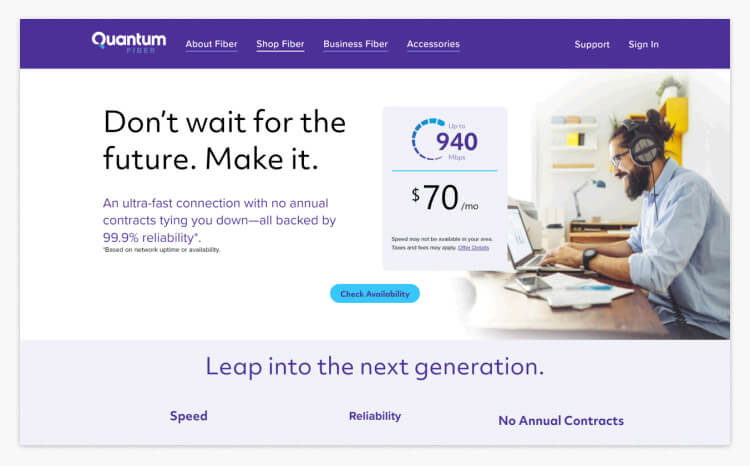

What Is an Internet Service Provider?
Internet service providers (also known as ISPs or broadband providers) are companies that provide internet and related services to consumers. More than 2,800 ISPs currently operate in the United States, according to BroadbandNow, a website that maintains an updated database of internet service providers. These companies range from a handful of large, nationwide ISPs to thousands of smaller, local providers (or subsidiaries of large providers).
What Are the Different Types of Internet Service Providers?
There are broadly five types of broadband internet infrastructure, each with their various pros and cons. The type of broadband available to you depends where you live and which internet service providers operate in your area.
According to the Federal Communications Commission (FCC), around two in five Americans now have access to high-speed fiber broadband. Other areas are limited to cable (which can also reach superfast speeds) or DSL, or in some rural areas to satellite and occasionally fixed wireless. If you’re interested, this page on the FCC website explains the inner workings of each type of broadband technology.
Here’s a breakdown of the speeds, reliability, affordability, and availability (one or more providers – last updated by the FCC in June 2019) of the various types of broadband infrastructure:
| Max download | Price | Reliability | Availability | |
|---|---|---|---|---|
| Fiber | 25 – 2000 Mbps | Very high | High | 39.18% |
| Cable | 10 – 1000 Mbps | High | High | 88.49% |
| DSL | 1-500 Mbps | Medium | Medium | 39.94% |
| Satellite | 1-100 Mbps | Medium | Low | 99.85% |
| Fixed wireless | 1-50 Mbps | Low | Low | 26.14% |
What Download Speed Do I Need?
One of the ways ISPs try to lure in new customers is by talking up their download speeds. While a fast internet connection is better than a slow one, faster costs more – and you may end up paying for more than you need. If you have a ‘smart household’ with lots of interconnected devices, then it might make sense to pay the maximum price for a superfast 1-gig (940-1000 Mbps) connection. But if your needs aren’t so complicated, then you can make do with a different plan.
Here’s a rough guide to recommended download speeds.
| Speed | Activities | Devices |
|---|---|---|
| 1000 Mbps | All of the below plus smart homes, 4K Ultra HD video and live streaming | Unlimited |
| 300 Mbps | All of the below plus large file sharing and 4K live streaming | 3-5 |
| 50 Mbps | All of the below plus 4K streaming, online multiplayer gaming | 2-3 |
| 10 Mbps | All of the below plus HD streaming | 1-2 |
| 3 Mbps | Email, web use, social media, standard definition (SD) streaming, high definition (SD) video calling | 1 |
When comparing internet service providers, don’t forget to look into their upload speeds! This is something many ISPs fail to mention, but it is vitally important in this new world of remote work. For a video conference or screen sharing app such as Zoom, 700 kbps is enough for 1-on-1 video calling in standard definition, while 1 Mbps is needed for group video calling in HD and 3.5-4 Mbps for video calling in 1080p HD. For video platforms like YouTube and Switch, you all you need to upload video is a basic connection. However, if you’re doing live streaming or you regularly upload videos and don’t want to be waiting hours, then you should aim for an internet package with at least 10-25 Mbps upload speeds.
How Much Should an ISP Cost?
The cost of an ISP depends on a number of factors including speed, added features, and perhaps most importantly the number of providers in your area. People living in big population centers with multiple providers may have access to cheaper internet than people in smaller towns where fewer ISPs bother to invest in infrastructure.
From a survey of top ISPs, you can expect to pay in the range of $25-35/month plus taxes for up to 25 Mbps download speeds, $30-40 for 100 Mbps, and $50-80 for 940 Mbps (packaged as a 1 gig plan). Many providers charge for equipment, so remember to factor this into your calculations when comparing different ISPs.
What Else Should I Look for When Comparing ISPs?
Speed is important, but it isn’t everything. Here are some of the other things to look for when comparing internet plans.
- Bundles. Many telecom companies bundle together internet, cable, and telephone into one package. Bundling your internet with other services can potentially save you money and it certainly makes your bills less complicated. However, be careful not to commit to things you don’t need, such as a landline you might never use.
- Introductory offers. One of the ways ISPs entice new customers is through discounted prices for the first 12 months. This is another great way to save money, but make sure to set yourself a reminder to compare prices again once the year is up.
- Added features. Common types of features offered by ISPs include: mobile app for controlling your Wi-Fi remotely; anti-virus protection through a third-party provider such as McAfee; and hotspot network for using internet away from home. These are often but not always included in the plan, so make sure to read the fine print.
- Customer service. Like with any service, it’s important to know you’re getting an ISP that offers good customer support. Before making your final decision, read plenty of customer reviews to find out if the provider really does what they say.
- Speeds in your area. ISPs will sell you on a certain download speed, but can they reach it in your area? Use the FCC search tool we mentioned earlier to compare speeds and ask neighbors how well their ISP performs.
Conclusion
According to the FCC, 99.9% of Americans now have access to two or more internet service providers and 70.9% have access to two or more providers when excluding satellite companies (which are available to virtually everyone). Where there is competition, there is choice. Before you decide which ISP to sign up with, don’t forget to properly compare the options and find the one that most suits you.
Our Top 3 Picks
- 1


 Fast, reliable fiber internet
Fast, reliable fiber internet- Best for - Unlimited data
- Starting price - $49
- Connection type - Fiber
Fast, reliable fiber internetRead Quantum Fiber ReviewWith its affordable fiber internet complete with unlimited data, Quantum Fiber is a steal. It offers home and small business internet solutions starting at $49 per month, and there are no annual contracts. You can cancel service anytime and without penalty.
One stand-out quality of Quantum Fiber is its stability. It can handle multiple devices streaming video, playing games, and sending and receiving large files without declining in speed or performance. The company is constantly expanding coverage area within the United States, and you get the speeds you actually pay for. This is the premier option if you’re looking for a reliable, affordable internet solution.
Quantum Fiber Pros & Cons
PROS
Affordable pricingNo contractsLightning fast internet speedsCONS
Not available nationwideHard to contact customer service - 2
.20220317095135.png)
.20220317095135.png)
 Built-in security and privacy controls
Built-in security and privacy controls- Best for - Families
- Starting price - $55/month for DSL, $70/month for fiber
- Connection type - DSL, fiber
Built-in security and privacy controlsRead CenturyLink ReviewCenturyLink offers internet in 16 states with speeds ranging from 3-100 Mbps for DSL internet and 100-940 Mbps for fiber, which is only available in selected areas. Its WiFi 6 advanced technology allows for faster connectivity, enhanced data capacity, and extended battery life for in-home devices.
CenturyLink Pros & Cons
PROS
Free wireless modem with Fiber Gigabit planNo annual contractsBuilt-in privacy and parental control toolsCONS
DSL options relatively expensive$149 installation fee on DSL plan


